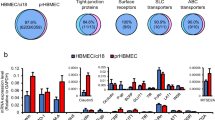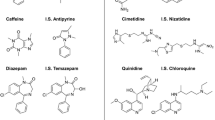Abstract
Purpose. Studies were conducted to evaluate whether the use of an in vitro model of the blood-brain barrier (BBB) resulted in more accurate predictions of the in vivo transport of compounds compared to the use of a human intestinal cell line (Caco-2).
Methods. The in vitro BBB model employs bovine brain capillary endothelial cells co-cultured with primary rat astrocytes. The Caco-2 cells originate from a human colorectal carcinoma. The rat was used as experimental animal for the in vivo studies.
Results. Strong correlations (r = 0.93-0.95) were found between the results generated by the in vitro model of the BBB and two different methodologies to measure the permeability across the BBB in vivo. In contrast, a poor correlation (r = 0.68) was obtained between Caco-2 cell data and in vivo BBB transport. A relatively poor correlation (r = 0.74) was also found between the two in vitro models.
Conclusion. The present study illustrates the limitations of the Caco-2 model to predict BBB permeability of compounds in vivo. The results emphasize the fact that the BBB and the intestinal mucosa are two fundamentally different biologic barriers, and to be able to make accurate predictions about the in vivo CNS penetration of potential drug candidates, it is important that the in vitro model possesses the main characteristics of the in vivo BBB.
Similar content being viewed by others
REFERENCES
A. L. Betz and G. W. Goldstein. Specialized properties and solute transport in brain capillaries. Annu. Rev. Physiol. 48:241–250 (1986).
S. Méresse, M. P. Dehouck, P. Delorme, M. Bensaid, J. P. Tauber, C. Delbart, J. C. Fruchart, and R. Cecchelli. Bovine Brain Endothelial Cells Express Tight Junctions and Monoamine Oxidase Activity in Long-Term Culture. J. Neurochem. 53:1363–1371 (1989).
A. Minn, J. F. Ghersi-Egea, R. Perrin, B. Leininger, and G. Siest. Drug metabolising enzymes in the brain and cerebral microvessels. Brain Res. Rev. 16:65–82 (1991).
B. Solhonne, C. Gros, H. Pollard, and J. C. Schwartz. Major localisation of aminopeptidase M in rat brain microvessels. Neuroscience 22:225–232 (1987).
L. Song, E. Wilk, S. Wilk, and D. P. Healy. Localization of immunoreactive glutamyl aminotranspeptidase in rat brain. I. Association with cerebral microvessels. Brain. Res. 606:286–294 (1993).
T. Tatsuta, M. Naito, T. Oh-hara, I. Sugawara, and T. Tsuruo. Functional involvement of P-glycoprotein in blood-brain barrier. J. Biol. Chem. 267:20383–20391 (1992).
A. Tsuji, I. Tamai, A. Sakata, Y. Tenda, and T. Terasaki. Restricted transport of ciclosporin A across the blood-brain barrier by a multidrug transporter, P-glycoprotein. Biochem. Pharmacol. 46:1096–1099 (1993).
A. H. Schinkel, J. J. M. Smit, O. van Tellingen, J. H. Beijnen, E. Wagenaar, L. van Deemter, C. A. A. M. Mol, M. A. van der Valk, E. C. Robanus-Maandag, H. P. J. te Riele, A. J. M. Berns, and P. Borst. Disruption of mouse mdr1a P-glycoprotein gene leads to deficiency in the blood-brain barrier and to increased sensitivity to drugs. Cell 77:491–502 (1994).
E. M. Cornford, L. D. Braun, and W. H. Oldendorf. Carriermediated blood-brain barrier of choline and certain choline analogs. J. Neurochem. 30:299–308 (1978).
K. L. Audus. R.L. Bartel, I.J. Hidalgo, and R.T Borchardt. The use of cultured epithelial and endothelial cells for drug transport and metabolism studies. Pharm. Res. 7:435–451 (1990).
M. P. Dehouck, S. Méresse, P. Delorme, J. C. Fruchart, and R. Cecchelli. An easier, Reproducible and Mass-production Method to study the Blood-Brain Barrier In Vitro. J. Neurochem. 54: 1798–1801 (1990).
R. Cecchelli, B. Dehouck, L. Descamps, L. Fenart, V. Buee-Scherrer, C. Duhem, S. Lundquist, M. Rentfel, G. Torpier, and M. P. Dehouck. In vitro model for evaluating drug transport across the blood-brain barrier. Adv. Drug. Deliv. Res. 5:165–178 (1999).
J. Booher and M. Sensenbrenner. Growth and Cultivation of Dissociated Neurons and Glial Cells from Embryonic Chick, Rat and Human Brain in Flask Cultures. Neurobiology 2:97–105 (1972).
L. Fenart, V. Buée-Scherrer, L. Descamps, C. Duhem, M. G. Poullain, R. Cecchelli, and M. P. Dehouck. Inhibition of Pglycoprotein: Rapid assessment of its implication in blood-brain barrier integrity and drug transport to the brain by an in vitro model of the blood-brain barrier. Pharm. Res. 15:993–1000 (1998).
A. Siflinger-Birnboim, P. C. Del Becchio, J. A. Cooper, J. N. Blumenstock, J. N. Shepard, and A. B. Malik. Molecular Sieving Characteristics of the Cultured Endothelial Monolayer. J. Cell. Physiol. 132:111–117 (1987).
M. Yazdanian, S. L. Glynn, J. L. Wright, and A. Hawi. Correlating Partitioning and Caco-2 Cell Permeability of Structurally Diverse Small Molecular Weight Compounds. Pharm. Res. 15:1490–1494 (1998).
W. H. Oldendorf. Blood-brain barrier, In H. Davson and M. B. Segal (eds), Physiology of the CSF and Blood-Brain Barriers, CRC Press, USA, 1996 pp. 77–78.
W. H. Oldendorf. Brain uptake of radiolabeled amino acids, amines and hexoses after arterial injection. Am. J. Physiol. 221: 1629–1639 (1971).
W. M. Pardridge and L. J. Mietus. Transport of Steroid Hormones through the Rat Blood-Brain Barrier. J. Clin. Invest. 64: 145–154 (1979).
W. M. Pardridge and R. Sakiyama. and G. Fierer. Blood-brain barrier transport and brain sequestration of propranolol and lidocaine. Am. J. Physiol. 247:R582–R588 (1984).
E. M. Cornford. The Blood-Brain Barrier, A Dynamic Regulatory Interface. Physiol. 7:219–259 (1985).
C. Crone and D. G. Levitt. Capillary permeability to small solutes, In E. M. Renkin, and C. C. Michel (eds), Handbook of Physiology. Section 2: The Cardiovascular system. Vol. 4: Microcirculation. Part 1. American Physiological Society, Maryland, 1984, pp. 411–466.
J. D. Fenstermacher and S. Rapoport. Blood-brain barrier. In Rencim, E. M. and Michel, C. C. (eds.), Handbook of Physiology Vol. 4, Section 2, American Physiological Society, Bethesda, 1986, pp. 969–1000.
J. D. Fenstermacher, Pharmacology of the Blood-Brain Barrier, In. E. A Neuwelt (ed), {tiImplications of the Blood-Brain Barrier and Its Manipulation. Vol.1}, Plenum Medical Book Company, New York, 1989 pp.137–155.
J. D. Fenstermacher. Drug transfer across the blood-brain barrier. In D. D. Breimer and P. Speiser (eds), Topics in Pharmaceutical Sciences. Elsevier, Amsterdam, 1983 pp.143–154.
W. M. Pardridge, D. Triguero, J. Yang, and P. A. Cancilla. Comparison of in vitro and in vivo models of drug transcytosis through the blood-brain barrier. J. Pharmacol. Exp. Ther. 253:884–891 (1990).
M. Bradbury. The concept of a Blood-Brain Barrier, Wiley, New York, (1979).
P. Artursson and R. T Borchardt. Intestinal drug absorption and metabolism in cell cultures: Caco-2 and beyond. Pharm. Res. 14: 1655–1658 (1997).
O. C. Meijer, E. C. de Lange, D. D. Breimer. A. G. de Boer J. O. Workel, and E. R. de Kloet. Penetration of dexamethasone into brain glucocorticoid targets is enhanced in mdr 1A P-glycoprotein knockout mice. Endocrinology 139:1789–1793 (1998).
Author information
Authors and Affiliations
Corresponding author
Rights and permissions
About this article
Cite this article
Lundquist, S., Renftel, M., Brillault, J. et al. Prediction of Drug Transport Through the Blood-Brain Barrier in Vivo: A Comparison Between Two in Vitro Cell Models. Pharm Res 19, 976–981 (2002). https://doi.org/10.1023/A:1016462205267
Issue Date:
DOI: https://doi.org/10.1023/A:1016462205267




